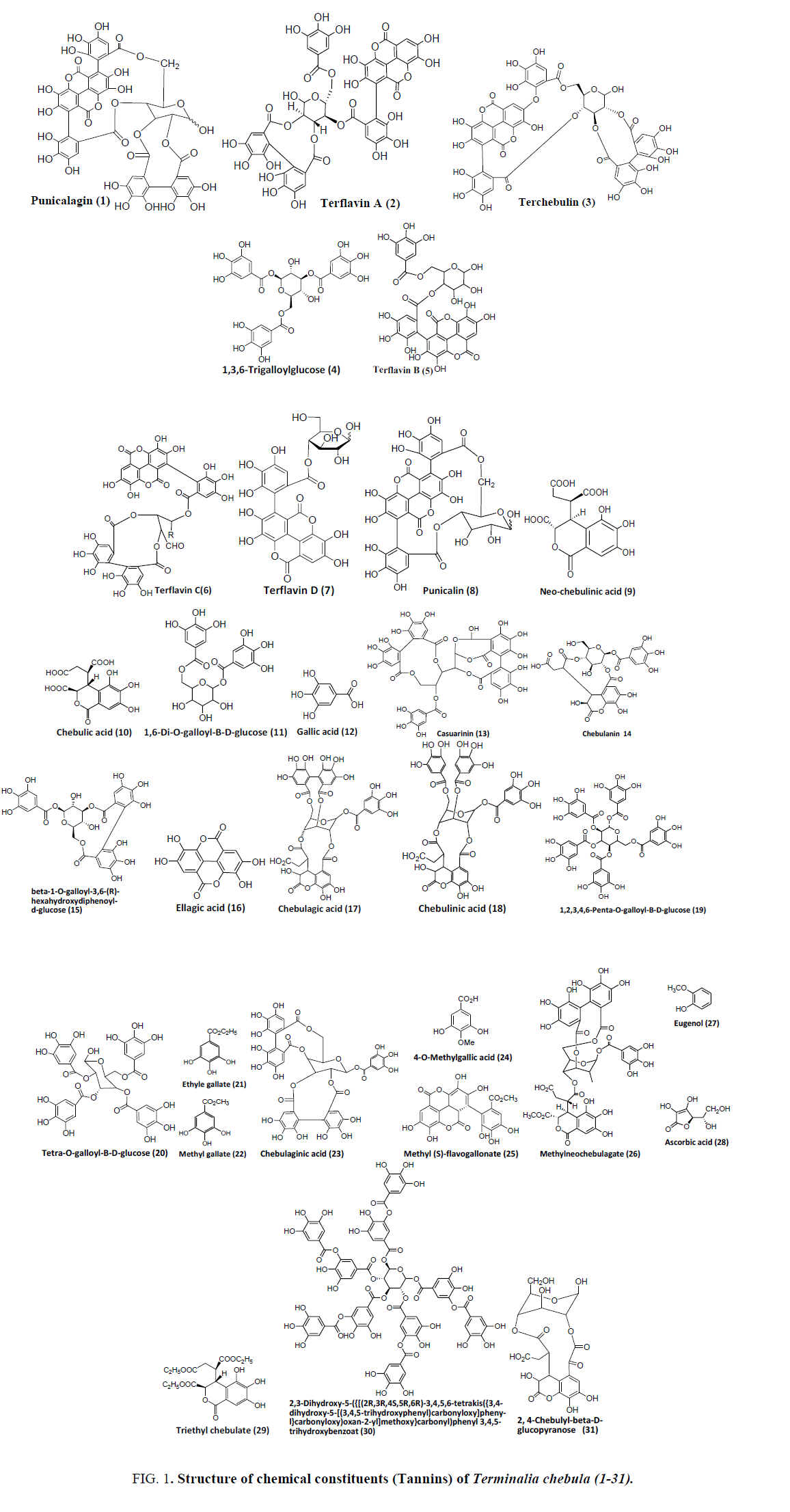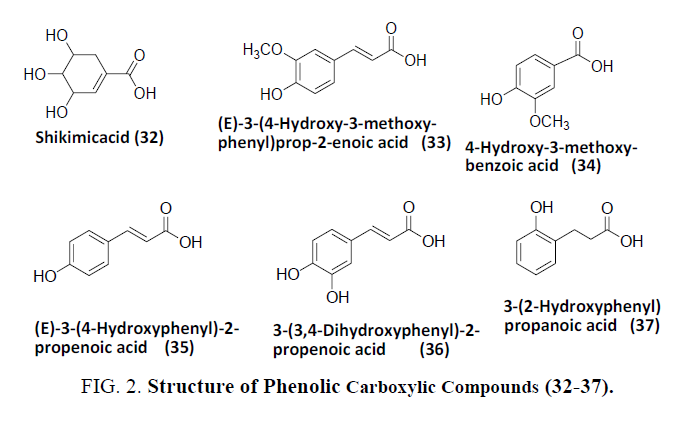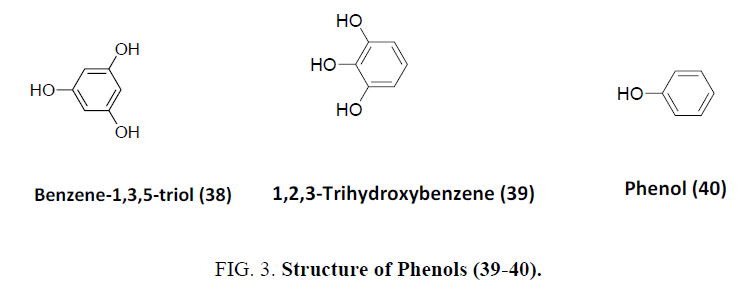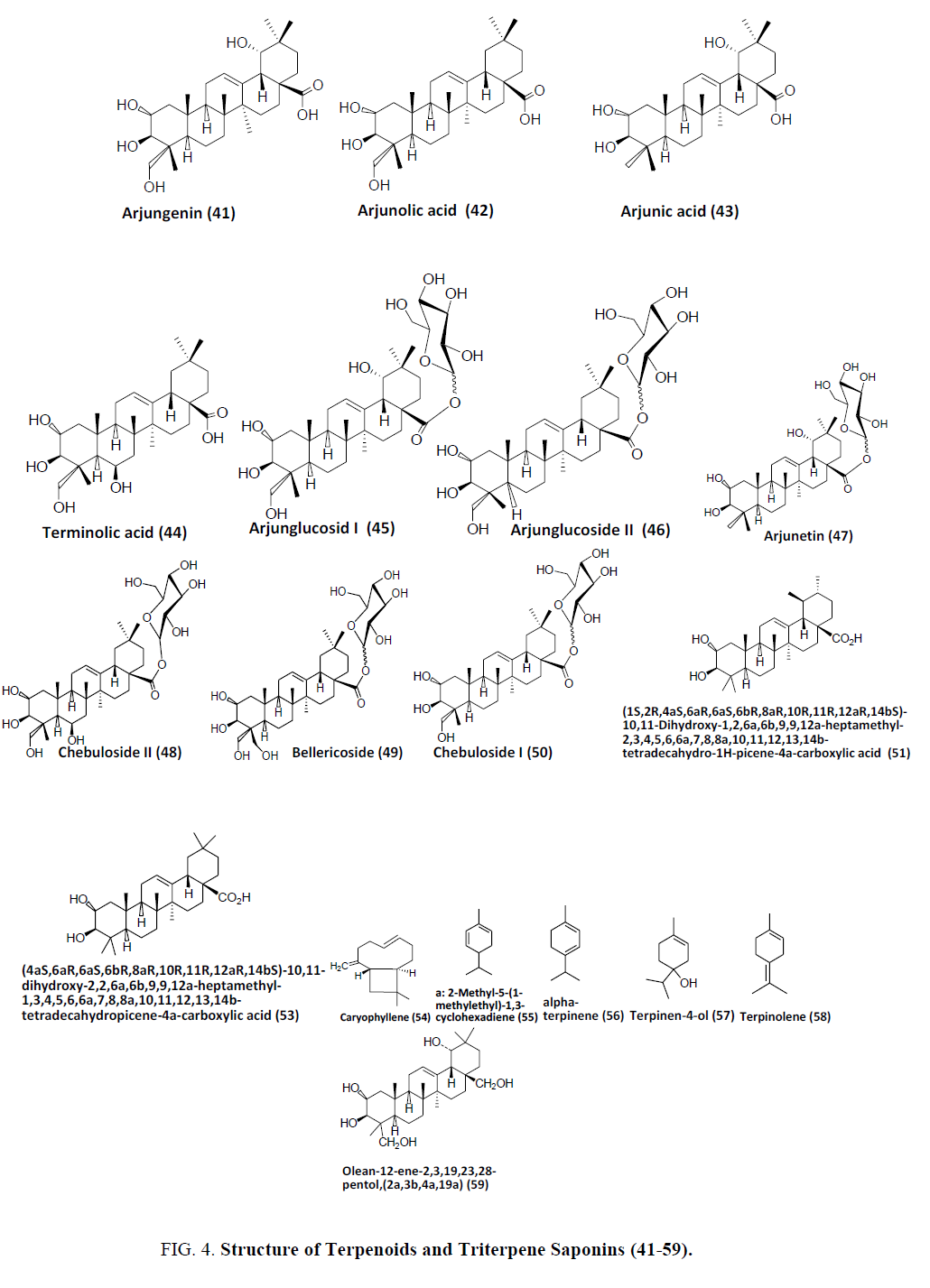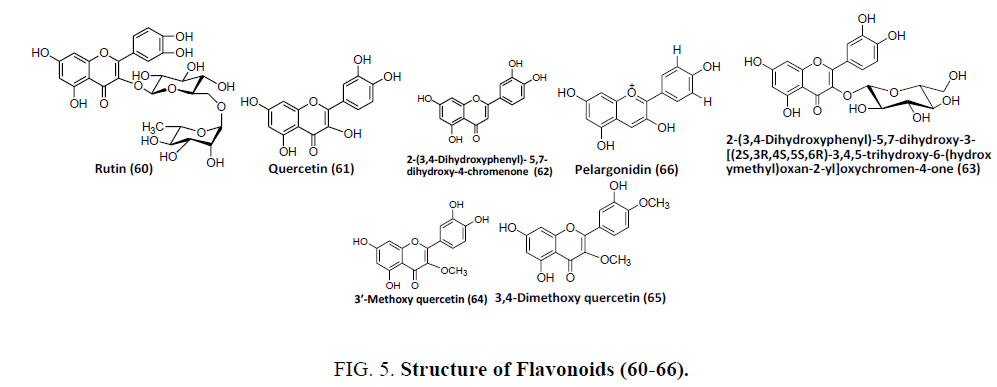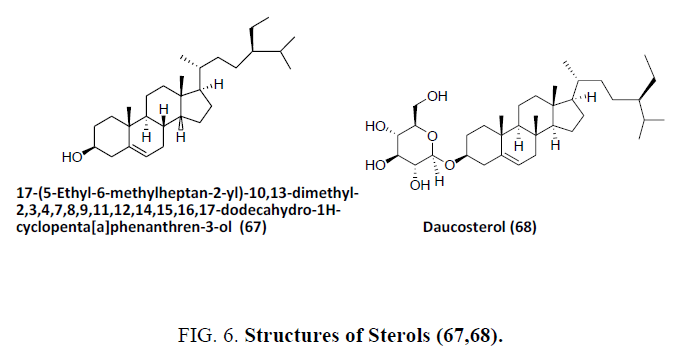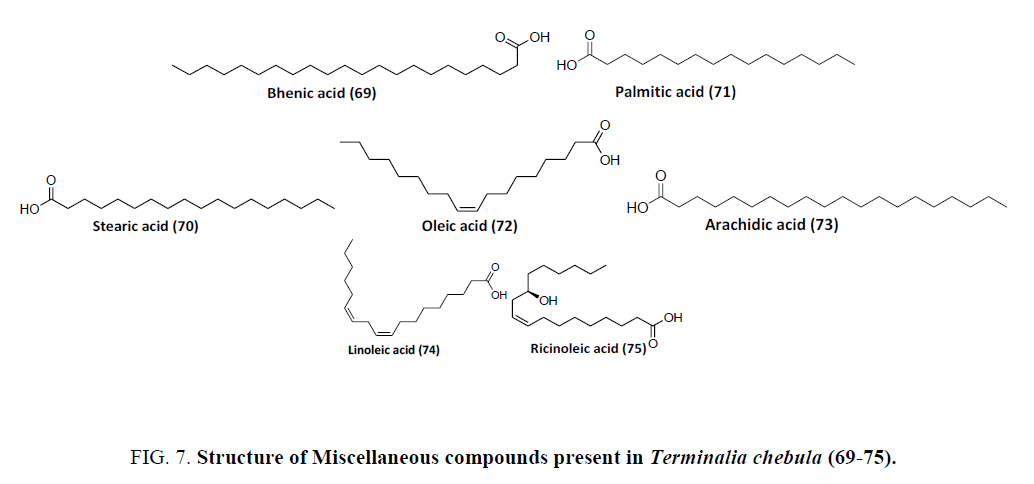Review
, Volume: 13( 2)Chemical Constituents of Terminalia chebula
- *Correspondence:
- Dr. Riaz M, Associate Professor, Department of Chemistry, University of Azad Jammu and Kashmir, Muzaffarabad, 13100, Pakistan, Tel: (92)334 9270235; E-mail: mriazm1@yahoo.com
Received: June 06, 2017; Accepted: October 27, 2017; Published: October 31, 2017
Citation: Riaz M, Khan O, Sherkheli MA, et al. Chemical Constituents of Terminalia Chebula. Nat Prod Ind J. 2017;13(2):112
Abstract
Despite the revolutionary progress and discoveries, the challenge to combat newly emerged and discovered diseases remains unmet. Natural products are still the prime reservoirs for providing new and novel molecular skeletons as drug candidates and inspiration. Terminalia chebula showed promising anti-microbial and anti-viral potentials and about 133 natural products have already been isolated from T. chebula and importantly, its richness of variety of metabolic enzymes are biosynthesizing diverse variety of secondary metabolites with attractive novelty and variety, ranging from phenolic derivative to flavonoids and falvins, terpenoids to steroids, alkaloids, tannins and their derivatives and glycosides. Molecular topology and variety in functionalities of in its natural products are important, especially dealing with the variable and adaptive capabilities of viruses and microorganism generated diseases. Importantly, it is useful for natural product chemist to have the updated chemical constituents of T. chebula.
Keywords
Terminalia Chebula; Chemical constituents; Nature unique diverse and rich variety
Introduction
Despite of the investments and progress in molecular biology and drug discovery, several infections by pathogenic microbes are major threats for human life. Development of various anti-microbial drugs have meaningfully controlled several pathogenic diseases or made them less destructive. However, emerging resistance against existing antibiotics has made them less effective and is a major threat to the humanity. Therefore the new antibiotics are crucially required on War-footing for the discovery and development of new antibiotics. Prevention of infections, tracking the resistant strains and proper use of antibiotics would be important precautionary measures. Natural products played the fundamental role as traditional herbal medicine and remedies and through advancement in the knowledge and research gave birth to the specific molecular medicines which also enhanced the structural and mechanistic understandings of biochemical entities and processes [1,2]. A major number of drugs have been derived or inspired from natural products [3,4]. Pain relieving properties of the Willow’s bark lead to the discovery of acetylsalicylic acid (aspirin) [5]. The first antibiotic, penicillin, was isolated from a mold, penicillium and terpenoidal anti-cancer taxol was isolated from Taxus brefolia [6]. Structural and functional biology andmedicinal chemistry have rewarded with revolutionary drugs [7], however, pathogenic micro-organism are major global risk to human health [8]. A progressive microbial resistance is an alarming threat causing community-acquired infections and antibiotic failure. Plants have been and are still the major, rich and diverse source of variety of phytochemicals including potent anti-microbial molecules [9]. Interestingly and presumably, since plant extracts contain many phytochemicals therefore, using plant extracts may pose some difficulty against the development of bacterial resistance as compared to the single molecular drug. Plants have provided anti-AIDS agents as well as anti-cancer taxol and homoharringtonine, benzylisoquinoline, papaverine with high inhibition to the replication of many viruses (e.g. cytomegalovirus, measles and HIV), atropisomeric naphthylisoquinoline dimers, michellamines A, B and C showed potential HIV-1 and HIV-2 on human lymphoblastoid target cell in vitro. Low cost to benefit ratio of natural product derived drugs is another attraction [3].
Experimental
Terminalia chebula
Terminalia chebula is a large sized traditional medicinal plant that is found in Pakistan, India, China and Tibet. It belongs togenus Terminalia which contains 250 species widely distributed throughout the tropical areas of the world. Traditionally, it is being used to treat gastrointestinal and urinary tract diseases, fever, cough, diarrhea, wound infections, skin diseases, urinary tract infection and candidiasis [10]. T. chebula possesses effective anti-bacterial and anti-viral activity against various bacterial strains [11,12].
Rich, diverse and novel nature molecular engineering (chemical constituents) in Terminalia chebula
Terminalia chebula habitats in tropical and sub-tropical diverse climatic condition and also is rich with metabolic engineeringenzymes, therefore it is extremely rich and diverse precursor for variety of natural products belonging to the various classes with different levels of biosynthesis. Richness, diversity and novelty of tannins and their analogues in T. chebula is a complex challenge both in term of isolation and structural modification but is an opportunity for the organic and medicinal chemists to modulate various biological disorders, especially pathogenic diseases because of their structural properties. Opportunity by T. chebula, is not limited to the tannins but also is fascinating with the provision of its small bioactive molecules which are very attractive for medicinal chemists and R&D organizations. Additionally, the variety of different classes of bioactive natural products in T. chebula further attracts the focused researchers which include, flavonoids, flavins, terpenoids, steroids, various phenols, functionalized aliphatic molecules and their glycosides (Figures 1-8). Structural diversity and novelty of the nature’s molecular engineering in T. chebula, especially in terms of in their skeletons, functionalities and linkages, is fascinating and invite focused and applied research to exploit their benefits in the form of new drugs (especially, antibiotics) further studies [13-31]. In addition, we understand and strongly propose that the standardization, efficacy, safety studies and documentations of its herbal products as of urgent prime importance. Focused and guided phytochemical re-investigation would be important and rewarding (Tables 1 to 7).
Figure 5: Structure of Flavonoids (60-66).
| # | Tannins | References |
|---|---|---|
| 1 | Punicalagin ((2, 3-(S)-hexahydroxydiphenoyl-4, 6-(S, S)-gallagyl-D-glucose) | [13] |
| 2 | terflavin A | [13] |
| 3 | Terchebulin | [13] |
| 4 | Terchebin (1, 3, 6-trigalloyl glucose,) | [14] |
| 5 | Terflavins B | [13] |
| 6 | Terflavin C | [13] |
| 7 | Terflavin D | [13] |
| 8 | Punicalin | [13] |
| 9 | Neo-chebulic acid | [15] |
| 10 | X+ | [15] |
| 11 | 1, 6-di-O-galloyl-D-glucose | [16] |
| 12 | Gallic acid (3, 4, 5-Trihydroxybenzoic acid) | [16] |
| 13 | Casuarinin | [16] |
| 14 | Chebulanin | [16] |
| 15 | Corilagin | [16] |
| 16 | Ellagic acid (2, 3, 7, 8-Tetrahydroxy-chromeno [5, 4, 3-cde]chromene-5, 10-dione) | [16] |
| 17 | Chebulagic acid | [16] |
| 18 | Chebulinic acid (1, 3, 6-Tri-O-galloyl-2, 4-chebuloyl-β-D-glucopyranoside) | [16] |
| 19 | 1, 2, 3, 4, 6-penta-O-galloyl-D-glucose | [16] |
| 20 | 2, 3, 4, 6-tetra-O-galloyl-B-D-glucose | [17] |
| 21 | Ethyl gallate (Ethyl 3, 4, 5-trihydroxybenzoate) | [17] |
| 22 | Methyl gallate (Methyl-3, 4, 5-trihydroxybenzoate) | [17] |
| 23 | Chebulaginic acid | [14] |
| 24 | 4-O-methylgallic acid | [18] |
| 25 | Methyl(S)-flavogallonate | [18] |
| 26 | Methyl neochebulagate | [18] |
| 27 | Eugenol | [19] |
| 28 | Ascorbic acid | [19] |
| 29 | Triethyl chebulate | [20] |
| 30 | Tannic acid [2, 3-dihydroxy-5-({[(2R,3R,4S,5R,6R)-3, 4, 5, 6-tetrakis({3, 4-dihydroxy-5-[(3, 4, 5-trihydroxyphenyl)carbonyloxy]phenyl}carbonyloxy)oxan-2-yl]methoxy}carbonyl)phenyl 3, 4, 5-trihydroxybenzoate] | [20] |
| 31 | 2, 4-Chebulyl-beta-D-glucopyranose | [13] |
Table 1: Chemical constituents of Terminalia chebula.
| # | Phenolic Carboxylic compounds | References |
|---|---|---|
| 32 | Shikimic acid | [20] |
| 33 | Ferulic acid | [20] |
| 34 | Vanillic acid | [20] |
| 35 | p-Coumaric acid | [20] |
| 36 | Caffeic acids | [20] |
| 37 | Melilotic acid | [21] |
Table 2: Phenolic Carboxylic compounds from Terminalia chebula.
| No. | Phenols | References |
|---|---|---|
| 38 | Phloroglucinol [benzene-1, 3, 5-triol ] | [21] |
| 39 | Pyragallol [1, 2, 3-Trihydroxybenzene] | [21] |
| 40 | Phenol | [22] |
Table 3: Phenols from Terminalia chebula.
| # | Terpenoids and Triterpene Saponins | Ref. |
|---|---|---|
| 41 | Arjungenin | [18] |
| 42 | Arjunolic acid | [18] |
| 43 | Arjunic acid | [18] |
| 44 | Terminolic acid | [18] |
| 45 | Arjunglucoside I | [18] |
| 46 | Arjunglucoside II | [18] |
| 47 | Arjunetin | [18] |
| 48 | Chebuloside II | [18] |
| 49 | Bellericoside | [23] |
| 50 | Chebuloside I [2α, 3β, 23-Trihydroxy-olean-12-en-28-oic Acid] | [24] |
| 51 | 2α-Hydroxyursolic acid | [24] |
| 52 | 2α-Hydroxymicromiric acid | [24] |
| 53 | Maslinic acid [(4aS, 6aR, 6aS, 6bR, 8aR, 10R, 11R, 12aR, 14bS)-10, 11-dihydroxy-2, 2, 6a, 6b, 9, 9, 12a-heptamethyl-1, 3, 4, 5, 6, 6a, 7, 8, 8a, 10, 11, 12, 13, 14b-tetradecahydropicene-4a-carboxylic acid] | [24] |
| 54 | β-caryophyllene | [25] |
| 55 | α-Phellandrene[α: 2-Methyl-5-(1-methylethyl)-1, 3-cyclohexadiene] | [25] |
| 56 | α-Terpinene | [25] |
| 57 | Terpinen-4-ol | [25] |
| 58 | Terpinolene | [25] |
| 59 | Chebupentol [Olean-12-ene-2, 3, 19, 23, 28-pentol,(2a, 3b, 4a, 19a)] | [25] |
Table 4: Triterpenoids and their Saponins from Terminalia chebula.
| # | Flavonoids | References |
|---|---|---|
| 60 | Rutin | [25] |
| 61 | Quercetin | [25] |
| 62 | Luteolin [2-(3, 4-Dihydroxyphenyl)-5, 7-dihydroxy-4-chromenone] | [26] |
| 63 | Isoquercetin [2-(3, 4-Dihydroxyphenyl)-5, 7-dihydroxy-3-[(2S, 3R, 4S, 5S, 6R)-3, 4, 5-Trihydroxy-6-(hydroxymethyl)oxan-2-yl]oxychromen-4-one] | [26] |
| 64 | 3’-Methoxy quercetin | [13] |
| 65 | 3, 4-Dimethoxy quercetin [5, 7-Dihydroxy-2-(3-hydroxy-4-methoxyphenyl)-3-Methoxy-4H-chromen-4-one] | [13] |
| 66 | Pelargonidin | [13] |
Table 5: Flavonoids isolated from Terminalia chebula.
Table 6: Sterols isolated from Terminalia chebula.
| No. | Miscellaneous compounds | References |
|---|---|---|
| 69 | Behenic acid [Docosanoic acid] | [25] |
| 70 | Stearic acid [Octadecanoic acid] | [25] |
| 71 | Palmitic acid [hexadecanoic acid] | [14,22] |
| 72 | Oleic acid [(9Z)-Octadec-9-enoic acid] | [14,22] |
| 73 | Arachidic acid [icosanoic acid] | [14,22] |
| 74 | Linoleic acid [9Z, 12Z)-9, 12-Octadecadienoic acid] | [14,22] |
| 75 | 12-Hydroxyoctadec-cis-9-enoic acid (ricinoleic acid) | [21] |
Table 7: Miscellaneous compounds from Terminalia chebula.
| No. | Compound isolate from Terminalia chebula fruit | Ref. |
|---|---|---|
| 76 | 2-Undecanone | [22] |
| 77 | Cyclododecane | [22] |
| 78 | 9-Octadecene | [22] |
| 79 | Hexadecane | [22] |
| 80 | Cylohexane | [22] |
| 81 | 8-Pentadecanone | [22] |
| 82 | 9-Eicosene | [22] |
| 83 | Triacontane | [22] |
| 84 | Tetradecane | [22] |
| 85 | Oxirane | [22] |
| 86 | 1, 16-Hexadecanediol | [22] |
| 87 | Heptylcyclohexane | [22] |
| 88 | 10-Nonadecanone | [22] |
| 89 | Phthalic acid | [22] |
| 90 | Tritetracontane | [22] |
| 91 | 9-Heptadecanone | [22] |
| 92 | Tetratetracontane | [22] |
| 93 | Linoleic acid ethyl ester | [22] |
| 94 | 9-Octadecenoic acid ethyl ester | [22] |
| 95 | 9, 12, 15-Octadecatrienoic acid | [22] |
| 96 | 1-Tricosene | [22] |
| 97 | 1, 19-Eicosadiene | [22] |
| 98 | Heptafluorobutyric acid | [22] |
| 99 | 1-Octanol | [22] |
| 100 | 1-Decanol | [22] |
| 101 | Cyclooctacosane | [22] |
| 102 | 1H-Indene | [22] |
| 103 | Hexacosyl pentafluoropropionate | [22] |
| 104 | Octatriacontyl pentafluoroprppionate | [22] |
| 105 | Tetratriacontane | [22] |
| 106 | 1, 2-benzenedicarboxylic acid | [22] |
| 107 | Ibogamin-9(17H)-ol [(9α)-12-Methoxy-16, 17-didehydro-9, 17-dihydroibogamin-9-ol] | [22] |
| 108 | 9-Tricosene | [22] |
| 109 | Tetratriacontyl heptafluorobutyrate | [22] |
| 110 | Dotricontyl heptafluorobutyrate | [22] |
| 111 | Tetracosanoic acid [Lignoceric acid] | [22] |
| 112 | Pentatriacontane | [22] |
| 113 | Eicosyl trifluoroacetate | [22] |
| 114 | Squalene | [22] |
| 115 | Tetracosyl heptafluorobutyrate | [22] |
| 116 | Tetratriacontyl heptafluorobutyrate | [22] |
| 118 | Heptafluorobutyric acid | [22] |
| 119 | Sulfurous acid | [22] |
| 120 | Octacosanoic acid | [22] |
| 121 | Vitamin E | [22] |
| 122 | Tetracosyl heptafluorobutyrate | [22] |
| 123 | Hexacosanoic acid | [22] |
| 124 | Octatriacontyl pentafluoropropionate | [22] |
| 125 | Triacontanoic acid [Melissic acid] | [22,25] |
| 126 | Tricosyl pentafluoropropionate | [22] |
| 127 | Acetic acid | [22] |
| 128 | Heptacosanoic acid | [22] |
| 129 | Tetratriacontyl pentafluoropropionate | [22] |
| 130 | Tetracosanoate | [22,28,29] |
| 131 | Kaempferol-3-rutinoside | [22,30] |
| 132 | Ethanedioic acid | [22,31] |
Table 8: Compounds from Terminalia chebula fruit.
Results, Discussion and Conclusion
In light of role of nature engineered secondary metabolites in pharmaceuticals, the structural and functional diversity and novelty of natural products of Terminalia chebula along with the rich and diverse biosynthesis, together with their wide range of therapeutic applications and importantly its valuable anti-pathogenic biological properties coupled with the burnings needs for new antibiotics, we conclude and propose:
1. Focused and guided phytochemical re-investigations on the Terminalia chebula and its herbal products,
2. Structure activity relation (SAR) further medicinal chemistry to explore the drug potentials of already known bioactive molecules of Terminalia chebula, especially anti-microbial agents.
Further studies for the standardization, formulation, documentation, efficacy and safety of traditional herbal medicinal products (THMPs) of Terminalia chebula . Hence, it is crucial to be shared with the relevant scientists.
References
- Piddock LJV. The crisis of no new antibiotics: What is the way forward? Lancet Infect Dis. 2012;12:249-53.
- Walsh CT, Wencewicz TA. Prospects for new antibiotics: A molecule-centered perspective. J Antibiot. 2013;67:7-22.
- Newman DJ, Cragg GM. Natural products as sources of new drugs over the 30 years from 1981 to 2010. J Nat Prod. 2012;75:311-35.
- Cragg GM, Newman DJ. Natural products: A continuing source of novel drug leads. BBA-Gen Subjects 2013;1830:3670-95.
- Cutler HG, Cutler SJ. Biologically active natural products: Agrochemicals, CRC Press, 1999.
- Fuster V, Sweeny JM. Aspirin a historical and contemporary therapeutic overview. Circulation. 2011;123:768-78.
- Wachtel-Galor S, Benzie I. Herbal medicine: An introduction to its history, usage, regulation, current trends and research needs. Oxidative Stress and Disease. 2011.
- Feldmann H. Ebola: A growing threat? N Engl J Med. 2014:371:1375-78.
- Couldwell DL, Tagg KA, Jeoffreys NJ, et al. Failure of moxifloxacin treatment in mycoplasma genitalium infections due to macrolide and fluoroquinolone resistance. Int J STD AIDS. 2013;24:822-28.
- Nishanth RP, Prasad T, Jyotsna RG, et al. Hepatoprotective effects of Terminalia chebula fruit extract against 2-AAF–induced hepatic damage in Albino mice: Role of MDR1 and COX-2. J Herbs Spices Med Plants. 2014;20: 402-20.
- Rathinamoorthy R, Thilagavathi G. Terminalia chebula: Review on pharmacological and biochemical studies. Int J Pharmtech Res. 2014;6:97-116.
- Lee D, Boo KH, Woo JK, et al. Anti-bacterial and anti-viral activities of extracts from Terminalia chebula barks. J Korean Soc Appl Biol Chem. 2011;54:295-98.
- Bag A, Bhattacharyya SK, Chattopadhyay RR. The development of Terminalia chebula Retz.(Combretaceae) in clinical research. Asian Pac J Trop Biomed. 2013;3:244-52.
- Walia H, Arora S. Terminalia chebula: A pharmacognistic account. J Med Plant Res. 2013;70:1351-61.
- Lee HS, Jung SH, Yun BS, et al. Isolation of chebulic acid from Terminalia chebula Retz. and its antioxidant effect in isolated rat hepatocytes. Arch Toxicol. 2006;81:211-18.
- Juang LJ, Sheu SJ, Lin TC. Determination of hydrolyzable tannins in the fruit of Terminalia chebula Retz. by high?performance liquid chromatography and capillary electrophoresis. J Sep Sci. 2004;27:718-24.
- Mahajan A, Pai N. Simultaneous isolation and identification of phytoconstituents from Terminalia chebula by preparative chromatography. J Chem Pharm Res. 201;2:97-103.
- Manosroi A, Jantrawut P, Ogihara E, et al. Biological activities of phenolic compounds and triterpenoids from the galls of Terminalia chebula. Chem Biodivers. 2013;10:1448-63.
- Kim HG, Cho JH, Jeong EY, et al. Growth-inhibiting activity of active component isolated from Terminalia chebula fruits against intestinal bacteria. J Food Prot. 2006;69:2205-09.
- Tariq AL, Reyaz AL. Quantitative phytochemical analysis of traditionally used medicinal plant Terminalia chebula. International Research Journal of Biotechnology. 2013;4:101-5.
- Hosamani KM. Terminalia chebula seed oil: A minor source of 12?hydroxyoctadec?cis?9?enoic acid: Natural products as a source for the food and agricultural industries. J Sci Food Agric. 1994;64:275-77.
- Singh G, Kumar P. Extraction, gas chromatography: Mass spectrometry analysis and screening of fruits of Terminalia chebula Retz. for its antimicrobial potential. Pharmacogn Res. 2013;5:162.
- Kundu AP, Mahato SB. Triterpenoids and their glycosides from Terminalia chebula. Phytochemistry. 1993;32:999-1002.
- Singh C. 2α-hydroxymicromeric acid, a pentacyclic triterpene from Terminalia chebula. Phytochemistry. 1990;29: 2348-50.
- Kumar BSA, Lakshman K, Jayaveera KN, et al. Estimation of rutin and quercetin in Amaranthus viridis Linn by HPLC. Asian J Exp Sci. 2009;23:51-4.
- Prakash SD, Satya SN, Vangalapati M, et al. Purification of chebulinic acid from Terminalia chebula species by column chromatography. J Chem Biol Phys Sci. 2012;2:1753.
- Mammen D, Bapat S, Ramesh (2012). An investigation to variation in constituents in the fruits of Terminalia chebula Retz. at different maturity stages. Int J Pharm Bio Sci. 2012;3:416-19.
- Firakova S, M. Sturdikova, Muckova M. Bioactive secondary metabolites produced by microorganisms associated with plants. Biologia. 2007;62:251-57.
- Inglis V, Roberts RJ, Bromage NR. Bacterial diseases of fish. Blackwell Scientific Publications 1993.
- Zoetendal EG, Akkermans AD, et al. (2001). The host genotype affects the bacterial community in the human gastronintestinal tract. Microb Ecol Health Dis. 2001;13:129-34.
- Lin T, Nonaka G, Nishioka I, et al. Tannins and related compounds. CII. Structures of terchebulin, an ellagitannin having a novel tetraphenylcarboxylic acid (terchebulic acid) moiety and biogenetically related tannins from Terminalia chebula Retz. Chem Pharm Bull. 1990;38:3004-8.
